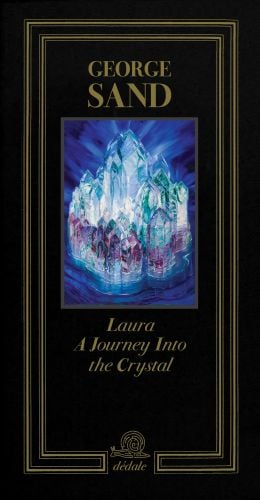Full Description
The third book in the Dédale series is Laura. Journey into the Crystal by George Sand, first published in 1864. Exploiting a fairy-tale narrative structure, George Sand actually sketches an imaginary universe, in which dimensional scales lose their meaning and everything is strongly influenced by the knowledge in geological matters. The scientific aspect, which was also known to Sand, is transfigured to the point that minerals begin to take on symbolic value and become cloaked in fascination and mystery.
The genesis of the novel and the echoes of Sand’s personal events are recounted in the preface edited by Isabelle Bardiès-Fronty.
The book is also enriched by the works of Wenzel Hablik, a Czech-born painter who later settled in Germany and who, a few decades after George Sand, was similarly enchanted by minerals and, in particular, crystals: his paintings, halfway between utopian architecture and fascinating fantasy, are a valuable rediscovery and seem to come from the same imaginary universe narrated by the French writer.
About the Author
George Sand, the pseudonym of Amantine Aurore Lucile Dupin de Francueil, was born in 1804 in Paris. She spent a large part of her childhood in Nohant at her paternal grandmother’s château, a place she always considered to be a happy refuge, crucial to her literary and personal development: there she was free to wear men's clothing, something she did for the rest of her life, and to live in contact with nature, an experience that would shape her ideals, making her an environmentalist ante litteram. This was reflected in her novels, particularly those of the ‘country series’. The first proofs, published around 1830 and almost immediately signed with her pseudonym, marked the start of a prolific literary career; as early as 1832 she enjoyed success with Indiana, and many of her later works were well received. Her life as an independent woman, as well as her ideals, are frequently reflected in her works. She was open to republican, feminist and socialist ideas, and her encounters and acquaintances, her liaisons with celebrities such as Alfred de Musset and Fryderyk Chopin, are well known. From 1849, she lived with her companion Alexandre Manceau in Nohant, where she died in 1876.
General conservator of the Musée de Cluny (Paris), Isabelle Bardiès-Fronty trained as a historian and art historian (École du Louvre, Universités Paris X-Nanterre and Paris-I Sorbonne) before winning the conservatorship competition. Called to direct the Metz museum in 1997, she carried out an extensive program to renovate this institution’s room, and a policy of temporary exhibitions and publication of the collections. Since 2007, she has been in charge of the ancient, early medieval, Byzantine and Islamic collections of the Musée de Cluny, as well as archeological artifacts in lead and terracotta from the 13th to 15th centuries. Of the 18 exhibitions she has curated, we must mention André Masson (1998), Le Chemin des reliques (2000), De la Lorraine (2004), Celtes et Scandinaves (2008), Le Bain et le Miroir (2009), Art du jeu, jeu dans l’art (2012), Les Temps mérovingiens (2016), Trésors de Lotharingie (2023) and Voyage dans le Cristal (2023-2024). The title of this last exhibition is a tribute to George Sand’s novel Laura, an inspiration to the entire exhibition universe, and for which Isabelle Bardiès-Fronty welcomed the collaboration of Stéphane Pennec.
Charline Coupeau is a specialist in antique jewelry and a gemologist, as well as a researcher at the L’ÉCOLE, School of Jewelry Arts in Paris. After several years exploring the diverse aspects of nineteenth-century jewels for her doctoral thesis in art history (at Montaigne University in Bordeaux), and having traveled extensively to explore the gems of the Indonesian archipelago (with the Institut National de Gemmologie in Paris), she began an inquiry into the relationship between two creative worlds, those of jewelry and literature, as a curator in partnership with the Bibliothèque nationale de France (“Bijoux et Littérature,” Les Essentiels, April 2024). Her latest publication is La Métaphysique du bijou (Metaphysics of jewels, PUR, 2002).
